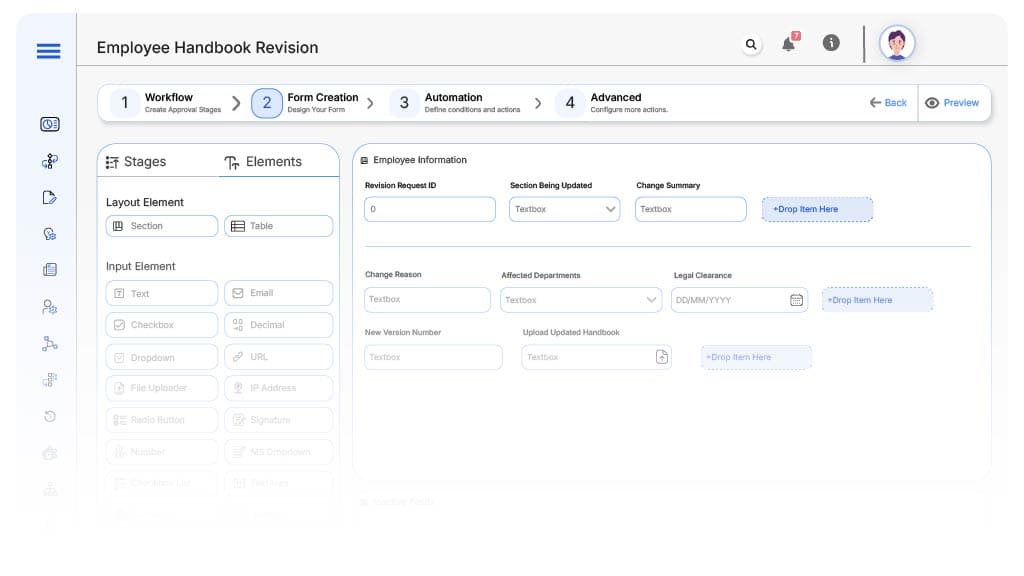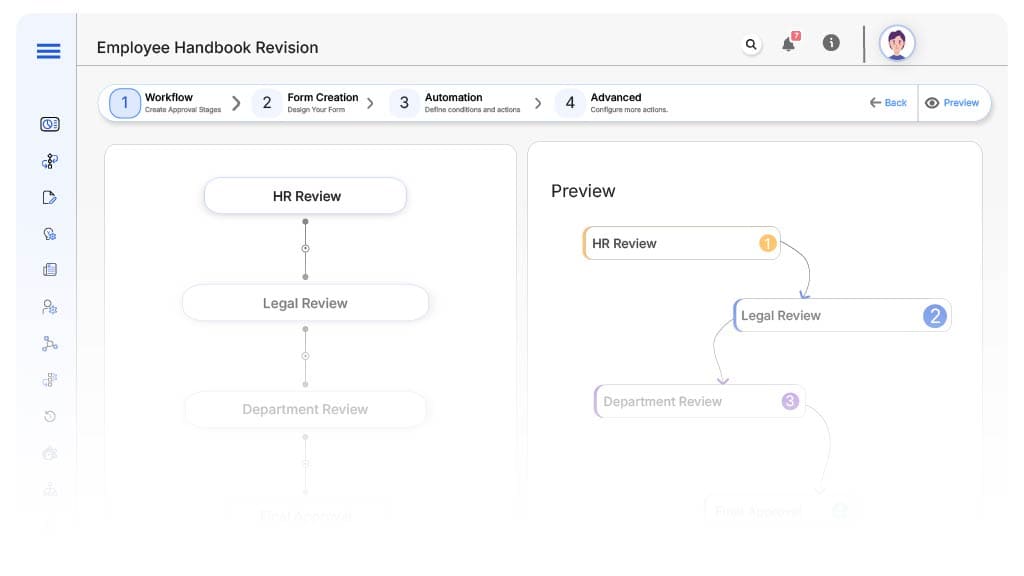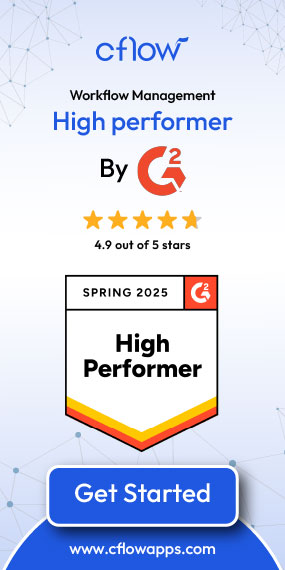- Cflow
- Employee Handbook Revision Automation
Employee Handbook Revision Automation
Learn how Cflow streamlines Employee Handbook Revisions for HR teams at mid-sized organizations, with step-by-step workflows, role-based reviews, field definitions, approval logic, and real examples.

Clow Team

The employee handbook is a vital HR document that outlines company policies, expectations, code of conduct, and benefits. As regulations, procedures, and internal policies evolve, HR teams must ensure the handbook remains current and legally compliant. Manual revisions often result in delays, missed updates, and a lack of proper version tracking.
Cflow enables HR teams to automate the entire employee handbook revision process – from change requests to legal reviews, department sign-offs, publishing, and employee acknowledgment. By digitizing this workflow, HR ensures a consistent, auditable, and collaborative update cycle.
What is Employee Handbook Revision Automation?
Employee Handbook Revision Automation governs how companies update, approve, and publish new versions of the employee handbook. It ensures every proposed change is reviewed by relevant departments (Legal, HR, Management), documented systematically, and rolled out uniformly across the organization.
For example, if a remote work policy changes, the system automatically routes the update to Legal for compliance validation, HR for tone and clarity, and leadership for final approval. The updated version is then sent to all employees for acknowledgment, ensuring complete transparency and traceability.
Why Automate Employee Handbook Revision?
Legal Compliance
Version Control
Cross-Department Collaboration
Acknowledgment Tracking
Audit Readiness
Key Benefits of Automating Employee Handbook Revisions with Cflow
- Centralized Revision Workflow: All change requests, approvals, and releases are managed in one unified system with full visibility, eliminating the need to chase documents over email. Teams operate from a single source of truth, and automated routing ensures revisions move efficiently across departments.
- Multi-Level Approvals: Each policy update is routed through HR, Legal, and Management based on the section being changed, ensuring every stakeholder signs off before release. This layered approach minimizes compliance risks and maintains consistency in governance.
- Version History & Archiving: Every approved version is stored with timestamps and rollback capability, giving HR instant access to past iterations. Cflow ensures each change is traceable, making it easy to audit or restore previous versions when necessary.
- Employee Acknowledgment Automation: When a new version is published, Cflow automatically sends acknowledgment requests to all employees and tracks who responded. HR can set due dates and escalation reminders, ensuring complete visibility and legal compliance.
- Change Reason Logging: Each revision includes a reason for change, which is stored alongside the update to clarify the intent behind edits. This transparency helps during policy reviews, audits, or disputes, creating a complete justification trail.
- Real-Time Dashboards: Cflow provides live dashboards showing pending approvals, policy gaps, and acknowledgment rates across the workforce. This helps HR prioritize follow-ups and make timely decisions based on actionable insights.
- Mobile-Friendly Access: Teams can review, approve, and track handbook revisions from mobile devices, allowing updates to continue even while remote. Cflow supports seamless participation and accountability from anywhere, without process disruption.
Get the best value for money with Cflow
User Roles & Permissions
HR Coordinator
- Responsibilities: Draft policy changes, initiate the revision process, and monitor progress.
- Permission: Admin
- Group: “HR Team”
Legal Reviewer
- Responsibilities: Validate legal compliance of proposed updates.
- Permission: Task Owner
- Group: “Legal”
Department Head
- Responsibilities: Review changes affecting their department’s policies.
- Permission: Approve
- Group: “Department Leaders”
Management/Leadership
- Responsibilities: Give final approval for handbook release.
- Permission: Approve
- Group: “Executive Management”
Legal or Compliance Auditor
- Responsibilities: Access archived records for audits or litigation defense.
- Cflow Permission Level: View Only.
- Mapping: “Compliance” group.
Employees
- Responsibilities: Read and acknowledge the published handbook.
- Permission: Submit Form
- Group: “All Employees”
Discover why teams choose Cflow
Form Design & Field Definitions

Field Label: Revision Request ID
- Type: Autonumber
- Auto-Populate: On form submission
Field Label: Section Being Updated
- Type: Dropdown
- Options: Code of Conduct, Leave Policy, IT Usage, Benefits, Others
Field Label: Change Summary
- Type: Text Area
- Logic: Required for all changes
Field Label: Change Reason
- Type: Text Area
- Logic: Required
Field Label: Affected Departments
- Type: Multi-select
- Options: HR, Legal, Finance, IT, Sales
Field Label: Legal Clearance
- Type: Checkbox
- Logic: Required before Management review
Field Label: Final Approval
- Type: Checkbox
- Logic: Required before employee acknowledgment
Field Label: New Version Number
- Type: Text
- Logic: Auto-generated or entered manually
Field Label: Upload Updated Handbook
- Type: File Upload
- Logic: Mandatory for final publication
Transform your Workflow with AI fusion
Approval Flow & Routing Logic

Submission → HR Review
- Status: Pending HR Initiation
- Notification: “Hi HR, a new handbook revision has been initiated. Please review the proposed changes.”
- On Approve: Routes to Legal
HR → Legal Review
- Status: Pending Legal Validation
- Notification: “Hi Legal, please validate the compliance of proposed updates.”
- On Approve: Routes to Relevant Department Heads
- Escalation: Reminder after 2 days
Legal → Department Review
- Status: Department Sign-Off
- Notification: “Hi Department Head, please review policy updates relevant to your team.”
- On Approve: Routes to Executive Approval
Department → Management Review
- Status: Final Review
- Notification: “Hi Management, handbook revision is ready for your approval.”
- On Approve: Routes to Employee Acknowledgment
Management → Employee Rollout
- Status: Acknowledgment Pending
- Notification: “Hi Employee, please review and acknowledge the latest version of the employee handbook.”
- On Submit: Marked complete
Final → Revision Complete
- Status: Revision Closed
- Notification: “Handbook revision completed and acknowledgments logged.”
Transform your AI-powered approvals
Implementation Steps in Cflow
Create a new workflow
Design the form
Set up User Roles/Groups
Build the process flow diagram
Configure notifications
Apply rules
Train Users
Go live
Example Scenario: Remote Work Policy Update
FAQ's
Unleash the full potential of your AI-powered Workflow

